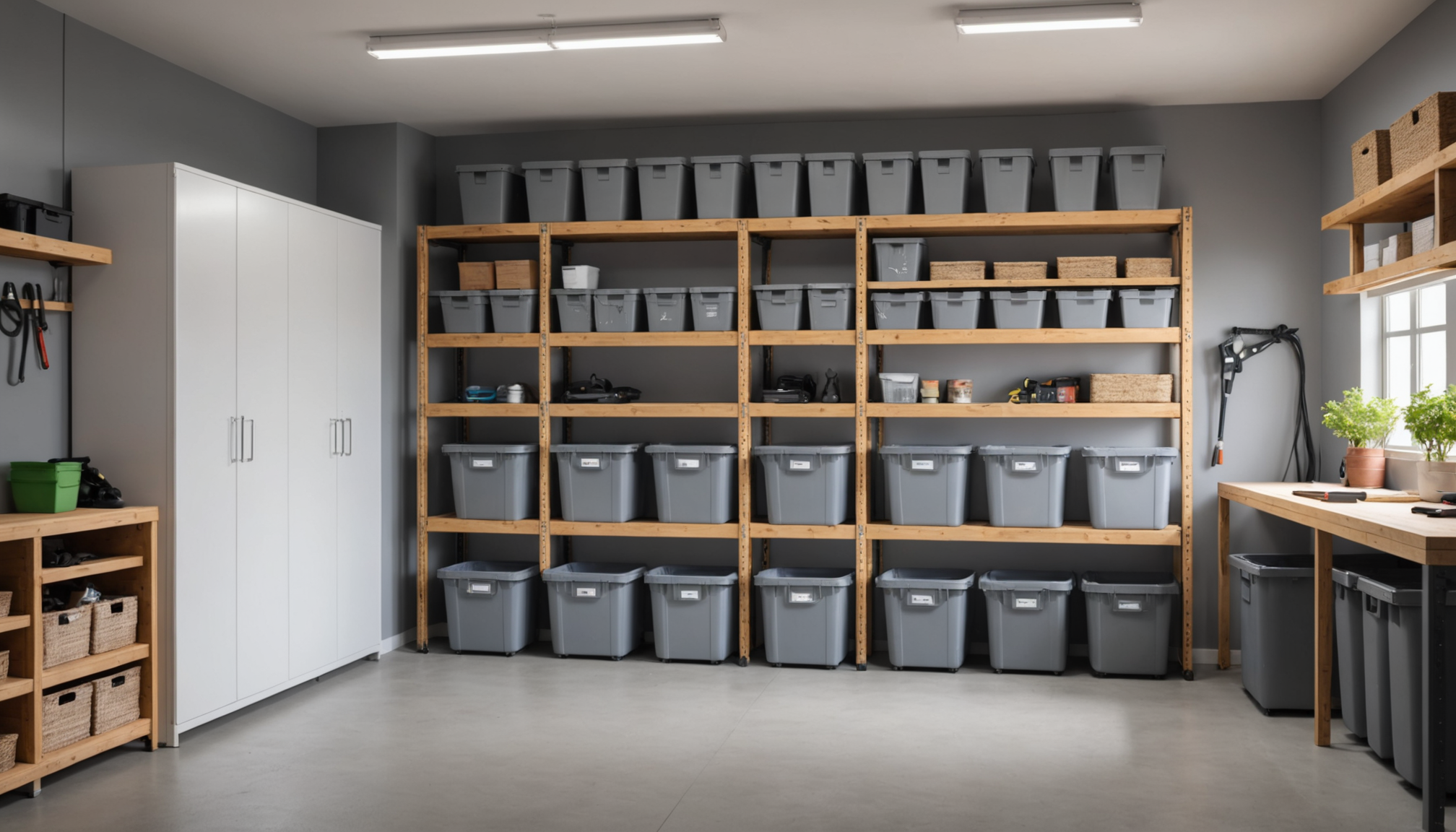If you’re looking to transform your garage from a cluttered chaos into an organized oasis, the first step involves implementing effective decluttering strategies. Approaching this task with a plan is essential to ensure a thorough and efficient process, making your garage a functional and inviting space once again.
The decluttering process should begin with an evaluation of your current items to determine their necessity and usefulness. Create categories to sort these items such as keep, donate, sell, and dispose of. Once you have your categories established, systematically go through each item:
- Keep: Retain only essentials or items that you use regularly. A good rule of thumb is the one-year rule; if you haven’t used it in the past year, consider if you genuinely need it.
- Donate: Items in good condition that you don’t use but could benefit someone else should be placed in this category. This not only aids those in need but also creates extra space.
- Sell: Some items might have a resale value. Consider selling them online or holding a garage sale to declutter while recouping some of your initial investment.
- Dispose: Broken or non-functional items should be thrown away or recycled. Be sure to follow local guidelines for disposing of hazardous materials like automotive fluids or old paint.
After categorizing, the next step is to establish a decluttering timeline. Tackling the entire garage in one go may seem overwhelming; instead, break the process into manageable chunks by focusing on specific sections or categories over several weekends.
Once you’ve decided what to keep, consider the most effective way to store these items. Pairing decluttering with a new organizational strategy can prevent future clutter from accumulating. Label bins and shelves to give each item a designated home. This organization not only helps remodel the space visually but also enhances the functionality by allowing easy access to frequently used items.
Consider the following table for a quick comparison of decluttering methods based on the time taken and potential impact:
| Method | Time Required | Potential Impact |
| Daily 10-minute declutter sessions | Minimal daily | High if consistently applied |
| Weekend marathon session | Intensive day-long effort | Immediate noticeable change |
| Monthly maintenance | Moderate monthly effort | Maintains a clutter-free environment |
Integrating the right decluttering strategies into your garage organization plan not only reinvigorates the space but also sets a strong foundation for ongoing maintenance, ensuring your garage remains a functional part of your home.
Smart storage solutions
Once you’ve cleared the clutter, enhancing your garage’s organization will largely depend on implementing smart storage solutions. A well-thought-out storage plan maximizes available space and ensures that every item has a designated spot, simplifying the process of finding and stowing away your belongings. Here’s how to effectively set up smart storage in your garage:
1. Assess Your Storage Needs:
– Begin by taking stock of what you have decided to keep. Categorize items into like groups such as tools, sports equipment, seasonal decorations, and gardening gear.
– Determine the volume of items in each category to prioritize storage needs and think about their accessibility depending on how often you use them.
2. Invest in Shelving Units:
– Opt for sturdy, adjustable shelving units to accommodate items of various sizes. Choose materials like metal or heavy-duty plastic, which are built to endure the garage environment.
– Install floor-to-ceiling shelves to maximize vertical space, making sure that items used frequently are placed at an easily reachable height.
3. Implement Clear Storage Bins:
– Use clear, stackable plastic bins to store smaller items. They allow you to see the contents easily without digging through each bin, thus saving time and frustration.
– Label each bin clearly with its contents using waterproof labels to maintain clarity even in the humid conditions often present in garages.
4. Pegboards and Slatwalls:
– Mount a pegboard or slatwall on an unused section of the wall to hang tools and equipment. This not only frees up shelf space but also keeps items visible and within easy reach.
– Organize items by purpose or task to streamline your workflow in the garage, and use hooks, baskets, and specialized holders to store tools like hammers, screwdrivers, and garden tools.
5. Ceiling Racks:
– For larger items that are not used frequently such as kayaks, seasonal tires, or holiday decor, consider installing ceiling storage racks. This keeps bulky items off the floor while utilizing overhead space.
– Ensure that the racks are securely anchored and can support the weight of the stored items.
6. Custom Cabinetry:
– If your budget allows, invest in custom cabinetry to provide a seamless, well-organized look. Closed cabinets help protect items from dust and make your space appear less cluttered.
– Utilize cabinets with adjustable shelves to adapt to the changing size of stored goods. Ensure easy access to items by installing cabinets with full-extension drawers when possible.
7. Utility Carts and Workbenches:
– Reserve a corner for a movable utility cart or a workbench with built-in storage for tools used in DIY projects or repairs. This mobility allows you to bring your work and materials directly to your project and return them easily afterward.
– Provide designated spots on the utility cart for the most frequently used tools and small hardware, making them easy to transport around the garage.
By strategically implementing these smart storage solutions, you can transform a cluttered garage into a well-organized, functional space that works for you, rather than against you. Keep your system flexible to evolve with changing needs and activities, ensuring your garage remains a convenient storage and work area.
Utilizing vertical space effectively
When looking to maximize your garage’s space and keep it organized, utilizing vertical space can be a game-changer. By rethinking how you use walls and ceilings, you can vastly expand storage capacity without encroaching on valuable floor space. Here are some effective ways to leverage vertical space in your garage for optimal organization:
Wall-Mounted Storage Systems: Installing a versatile wall storage system can transform your garage’s potential. Systems like slatwalls or grid panels create an upright surface to which various hooks, shelves, and baskets can be attached, making it ideal for hanging tools, garden hoses, or sports equipment. The adaptability of these systems lets you reconfigure or add components as needed, maintaining functionality as your storage needs evolve.
Clever Shelf Placement: While shelving units are a staple in garage organization, consider extending them upwards. Floor-to-ceiling shelves capitalize on vertical space often left unused. Place occasionally used or bulkier items on upper shelves, reserving lower, more accessible shelves for everyday essentials. Ensuring shelves are sturdy enough to sustain the stored weight is crucial for safety and longevity.
Overhead Storage Solutions: Utilize ceiling space for bulky seasonal items or gear that’s only sporadically needed, such as camping equipment or holiday decorations. Overhead storage racks provide an elevated solution for these objects, freeing up floor and wall space. Opt for adjustable and sturdy racks that can safely bear the weight of stored items.
Bike Hoists and Hooks: If your garage houses bicycles, floor space can quickly become limited. Ceiling bike hoists are simple yet effective systems that let you raise and lower bikes with ease, using a pulley mechanism. Alternatively, wall-mounted bike hooks keep bikes off the ground and leave more room for other activities or equipment storage.
Magnetic Strips and Tool Holders: For hand tools and smaller metal items, magnetic strips affixed to walls can keep everything organized and within reach. They’re perfect for workshops or for storing frequently used tools, making the work process more efficient as you easily grab what you need without rummaging through drawers.
Employing these vertical organization techniques not only ensures your garage remains clean and uncluttered but also optimizes every inch of space for maximum utility. By thinking vertically, you’re effectively doubling your storage potential, creating a more accessible, functional, and enjoyable space for all your projects and hobbies. Such strategic use of available space is not just about storing more items; it’s about doing so in a way that aligns with your daily activities and long-term needs, improving both convenience and accessibility.
Zone-based organization techniques
Creating a logical and efficient setup can drastically enhance both functionality and accessibility within your garage. Begin by defining specific areas dedicated to particular tasks or types of items. This approach helps minimize clutter and speeds up the process of finding what you need.
For starters, consider designating a section for tools and equipment. If you frequently engage in home improvement or repair projects, having a well-organized tool area is essential. Incorporate elements like a workbench with integrated tool storage, or hang tools on a pegboard where they’re easy to see and reach. Group tools by task, like all carpentry tools together, so you’re not hunting across different areas when you’ve got a project underway.
Next, allocate a spot for sports gear if you or your family participate in athletic activities. Make use of bins, mesh bags, or wall-mounted racks to store balls, bats, helmets, and other gear, organizing by specific sport or activity. Keeping this section near the garage door can be particularly handy, allowing for easy grab-and-go access.
Furthermore, dedicate an area for garden and yard supplies. Storing these items together keeps dirt and clutter contained. Utilize sturdy shelving for storing pots, fertilizers, and small tools, and hang larger tools like rakes and shovels on a tool rack or hooks. This prevents a tangled mess and facilitates easy access when it’s time for yard work.
A dedicated space for household overflow or bulk purchases can also be a beneficial zone, especially for homes that lack extensive pantry storage. Shelving units can hold non-perishable items, cleaning supplies, or even overflow of kitchen gadgets and seasonal dinnerware. Label shelves to streamline the location of specific items.
Lastly, don’t forget to cater for a seasonal gear section. Whether it’s holiday decorations or summer camping equipment, designating a specific zone reduces time spent searching through boxes. Store these items in clearly labeled bins or according to season. There’s nothing more frustrating than digging through winter gear to find a summer tent!
The beauty of zoning lies in its ability to create a systematic, orderly environment where every item has its place, reducing the visual chaos that often characterizes garages. Adjust the zones as your needs change, keeping flexibility in mind, as personal hobbies or family activities evolve. This organization method not only makes the garage more inviting and functional but also ensures that every return to the space is met with efficiency and ease. Remember, a well-defined garage space saves time, keeps stress levels low, and contributes positively to the overall organization of your home.
Seasonal gear and tool arrangements
Arranging your seasonal gear and tools efficiently is integral to maintaining a streamlined and functional garage throughout the year. Start by categorizing your items based on season and usage frequency. Ensure that items used together are stored together, making transitions between seasons smoother and more efficient.
Consider using clear, labeled bins to store your seasonal decor, making it easy to identify and access each collection when needed. Storing these bins on higher shelves frees up valuable space for more frequently used items. Another option is to designate a specific section of your shelving unit exclusively for seasonal items. This not only ensures they are easily accessible but also keeps them from getting mixed up with other household goods.
For tools and gear that see regular use during specific seasons, such as gardening tools in the spring and summer or snow shovels in the winter, position them at eye level or along the perimeter of your garage workspace for easy reach. Strategically placed wall-mounted racks or pegboards can be particularly effective for hanging tools vertically, keeping them organized and off the floor.
Sports equipment that varies by season, like skiing gear versus beach chairs and umbrellas, can also benefit from seasonal rotation. Consider using a duo of storage racks or bins on wheels; this mobility allows for quick reorganization as the seasons change. Items such as seasonal sports gear should be placed in a location that is easily accessible from your car, making it quick and convenient to load and unload.
For tech-savvy organization enthusiasts, consider implementing digital solutions such as inventory apps. These apps can help you keep track of where items are stored and alert you when it is time to swap in-season items, reducing the time spent searching for misplaced tools or gear.
Integrating an organization strategy that anticipates seasonal shifts ensures your garage remains an efficient and orderly space year-round. Not only does this planning minimize clutter and stress, but it also maximizes the functional utility of your garage, turning it into a smoothly operating extension of your home rather than an overstuffed storage void.
In conclusion, transforming your garage into an organized haven involves a blend of effective decluttering, clever storage, and strategic zoning. By utilizing these comprehensive tips, you’ll be able to reclaim control over your space, keeping it tidy and functional throughout the year. Whether you’re storing seasonal gear or creating specific zones for different tasks, staying organized will streamline your household operations and elevate the garage’s utility, ensuring it’s both a practical and pleasant part of your home.


